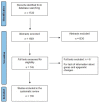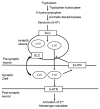A Comprehensive Review of the Genetic and Epigenetic Contributions to the Development of Fibromyalgia
- PMID: 37189737
- PMCID: PMC10135661
- DOI: 10.3390/biomedicines11041119
A Comprehensive Review of the Genetic and Epigenetic Contributions to the Development of Fibromyalgia
Abstract
This narrative review summarizes the current knowledge of the genetic and epigenetic contributions to the development of fibromyalgia (FM). Although there is no single gene that results in the development of FM, this study reveals that certain polymorphisms in genes involved in the catecholaminergic pathway, the serotonergic pathway, pain processing, oxidative stress, and inflammation may influence susceptibility to FM and the severity of its symptoms. Furthermore, epigenetic changes at the DNA level may lead to the development of FM. Likewise, microRNAs may impact the expression of certain proteins that lead to the worsening of FM-associated symptoms.
Keywords: epigenetics; fibromyalgia; genetics.
Conflict of interest statement
The authors declare no conflict of interest.
Figures
References
Publication types
LinkOut - more resources
Full Text Sources



